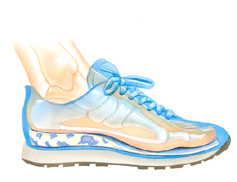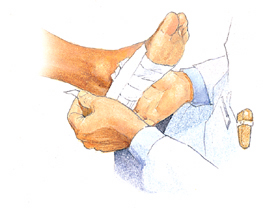Plantar Fasciitis
Plantar fasciitis (heel spur syndrome) is a common problem. It starts as a dull pain in the heel that comes and goes. It may become a sharp pain all the time.
It is often worse when you take your first steps in the morning or after sitting. It may also be worse after standing or walking and when you start a sports activity.
The plantar fascia is a thick fibrous material on the bottom of your foot. It is attached to your heel bone and fans forward toward your toes. It acts like a bowstring to hold the arch of the foot.

When you are active, your body weight shifts from your heel to the ball of your foot. This action places tension on the fascia.
The problem may start when part of the fascia is repeatedly placed under tension, such as in running. The tension causes inflammation, usually where the fascia is attached to the heel bone. The result is pain. The pain may also be in the middle of the foot or near the toes.
Some people with plantar fasciitis have heel spurs. The spurs do not cause the pain. Heel spurs also occur in people without pain.
Causes
Many factors play a role in this problem:
-
Flat feet
-
High, arched rigid feet
-
Poor shoe support
-
Running on your toes or on hills
-
Running on soft ground, such as running on sand
-
Getting older
-
Sudden increase in weight
-
Sudden increase in activity level
-
Family tendency
-
Tight Achilles tendon (heel cord)
-
Stiff big toe
Sports
Plantar fasciitis can get worse from any activity in which weight is placed on your feet. Any activity in which the foot lands repeatedly, such as walking or jogging, can make the problem worse.
To stay fit, replace weight-bearing sports with sports such as swimming or cycling. These sports put no weight on your feet. You can also do weight training to keep up your leg strength.
While you recover from plantar fasciitis, return to sports activities slowly. If you have a lot of pain during the activity or the next morning, you are doing too much.
It may help the problem if you use heel pads or change to new or different shoes.
Treatment
It may take a long time to get better, especially if you have had the condition for a long time. During recovery, lose weight, wear good shoes, and take it easy. These all help your injury to heal. Wear your shoes and arch supports or orthotics if you have them as soon as you get out of bed in the morning.
Rest
Use pain as your guide. If your foot is painful, rest it. Do not go barefoot. Wear your shoes and inserts.
Ice
Ice the sore area 2 or 3 times a day with an ice cup for 3 to 7 minutes. Also ice the sore area after activity.
Medicine
Taking an anti-inflammatory or pain relief pill may help to relieve pain and reduce inflammation.
Physical Therapy
The first goal of physical therapy, when needed, is to decrease the inflammation and increase the flexibility of tight muscles. Later, you can strengthen the small muscles of the foot to support the weakened plantar fascia.
Heel pads
A heel pad of felt, sponge or man-made material can help to spread, equalize and absorb the shock as your heel lands. This eases the pressure on the plantar fascia. You may need to cut a hole in the heel pad so the painful area will not be irritated.
|
Orthotics
Arch supports or shoe inserts are often helpful. They may be bought off the shelf or custom made to your foot.
Shoes
Your doctor may recommend certain shoes to best support your foot.
|

|
|
Taping
Your doctor may tape your foot to hold the arch. This will take some of the tension off the plantar fascia.
|

|
Injections
In some cases, your doctor may recommend a cortisone injection.
Surgery
Surgery is rarely needed for plantar fasciitis. It would be done only if all other treatments fail and pain is still severe after several months of treatment.